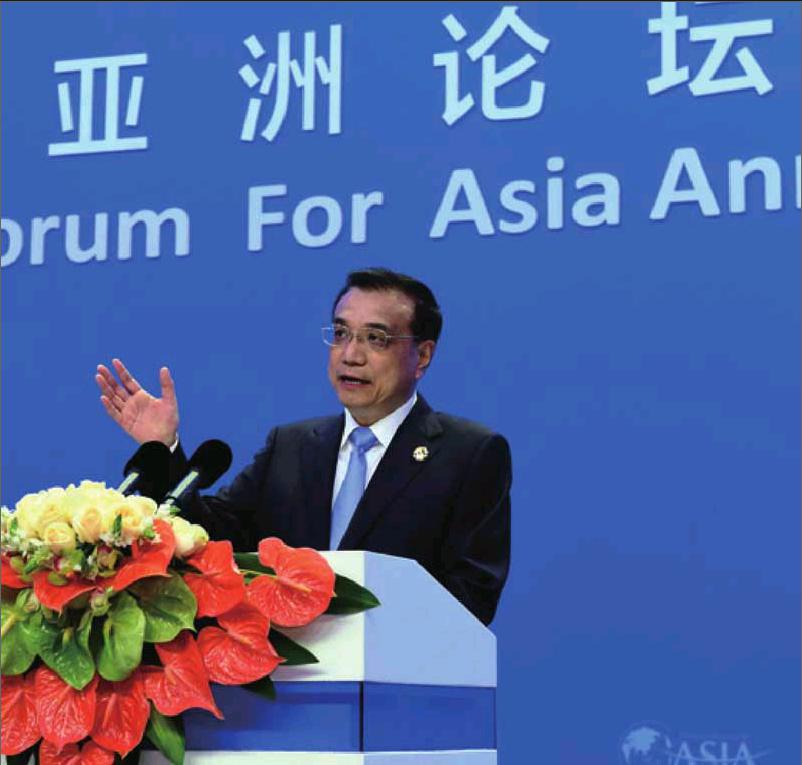TAPPING INTO POTENTIAL
2016-04-13ByDengYaqing
By+Deng+Yaqing

In Hainans coastal town of Boao, which means “teeming with fat fish” in Chinese, panels made up of government officials, business leaders and scholars articulated their views on how to fuel Asias economic development and deal with potential risks and challenges. Having been battered by the global financial crisis, developing countries now seek to recover and revitalize their economic prospects. Thats why “new” was the most-repeated keyword on the lips of participants.
Under the theme of Asias New Future: New Dynamics, New Vision, the Boao Forum for Asia (BFA) Annual Conference 2016 attracted 2,100 representatives from 62 countries and regions, of whom 13 were heads of state. “Although eight years have elapsed since the eruption of the global financial crisis, the world is still by and large in its shadow and amidst a series of profound adjustments. While developed economies have picked up the pieces and are trying to sustain a sluggish recovery, the developing world is still fragmented,” said Chinese Premier Li Keqiang at the opening ceremony.
Currently, the top 11 emerging economies have fallen into four echelons—China and India with a growth rate hovering at about 7 percent, Indonesia at roughly 5 percent, with Brazil and Russia suffering negative growth. Other emerging economies that are part of the G20 including Argentina, South Korea, Mexico, Saudi Arabia, South Africa and Turkey, all registered a growth range of zero to 3 percent. These figures are based on a report on the Development of Emerging Economies released by the Institute of World Economy and Politics of the Chinese Academy of Social Sciences.
All countries are facing pressure and have not completely shaken off the negative impact of the global financial collapse, said Vice Chairman of the BFA Zeng Peiyan, who listed exchange rate devaluation, declining oil prices, and the massive debts on the shoulders of developed countries as three main risks confronting the global economy.
Asia outlook
Zhu Min, Deputy Managing Director of the International Monetary Fund, disagreed over the view that Asia will experience a sharp slowdown in the future and argued that it is still the most dynamic economic region in the world.“Asia accounts for 40 percent of the global economic aggregate, and is expected to register 6.5-percent growth in 2016, which would be an extraordinary achievement in the context of a weak global recovery,” said Zhu.
Zhus argument was echoed by Huang Yiping, a professor at the National School of Development at Peking University, who hailed Asia as the engine leading global economic growth, but at the same time, underlined two challenges posed by its growth pattern.
In the past, the most successful economies in East Asia were export-oriented and therefore benefited substantially from globalization. However, since the outbreak of the financial crisis, the expansion of the export market slowed, therefore leading to some Western politicianssqueamishness toward opening up. That created obstacles in seeking export-oriented growth. “Asian countries have to depend more on domestic demand and pay more attention to regional cooperation,” said Huang.
According to the Progress of Asian Economic Integration Annual Report 2016 published at the forum, Asia has seen its role as a leader in foreign trade eroding. For one thing, its comparative advantage is not as distinct as it had been in the past two decades. Also, its growth in foreign trade has lagged behind GDP growth.
“Current levels of interdependency among Asian economies is far lower than the record high 60 percent registered in 2012, and in fact, except for Hong Kong and Australia, almost all the major Asian economies have seen their dependency on their Asian partners declining in terms of trade,” said Lin Guijun, Vice President of the University of International Business and Economics. For example, Chinas trade dependency on other Asian countries went down from 55.6 percent in 2011 to 46.5 percent in 2014.
On the other side, many once prosperous industries are no longer viable these days. Take China for example. A major task that it has set for itself is to replace traditional industries with newer ones.
Chinas economy was primarily fueled by exports and investments over the past few decades. More specifically, these sectors were fueled by the labor-intensive manufacturing industry in Chinas southeast coastal region and the resource-intensive heavy industry in the northwestern and northeastern parts of the country.
When those two engines werent able to drive growth forward any more, the country turned to high value-added, hi-tech, new manufacturing and service industries for further development, said Huang. He also pointed out thats still the case in countries that became mired in the middle-income trap, such as Malaysia, Indonesia, the Philippines and Thailand.
“The main ingredient in the recipe to create growth potential is reform. Different countries need different types of reform. Some countries have to carry out supply-side reform, rectify the labor market, liberalize the capital market and improve the competitiveness of state-owned enterprises. Other countries may need to push for demand-side reform,” said Wei Shangjin, chief economist at the Asian Development Bank.
Optimistic about China
Last year, Chinas GDP only grew at 6.9 percent, the slowest pace in 25 years. “Its not likely to be crippled by a hard landing, because Chinas slowdown is accompanied by growth and improvement in the quality of its economy,” said Zeng, noting that the current 7-or-so-percent growth is equivalent to the 10-percent growth that was reported five years ago in terms of growth value.
Amidst its all-round promotion of supplyside structural reform and the anemic global recovery, the Chinese Government set its 2016 target at 6.5-7 percent. Justin Yifu Lin, Honorary Dean of the National School of Development at Peking University, believed that China stands a good chance to achieve its goal. “As opposed to developed countries, China is still teeming with investment opportunities,” said Lin, who claimed that investment could flow to industrial upgrading, infrastructure construction, urbanization and environmental protection.
“China has plenty of financial resources to invest,” said Lin. Government debts make up less than 60 percent of the nations GDP, the lowest level among all other countries. Also, the private savings rate stands at 50 percent, ranking first in the world. Furthermore, the foreign exchange reserves in China amount to roughly$3.3 trillion.
“Abundant investment opportunities in combination with other resources to be invested in will maintain growth at a reasonable level, create jobs, elevate household income and therefore boost consumption,” said Lin, stressing that Chinas economy has strong elasticity, huge potential and ample room for policy maneuvers.
Witnessing the global economys profound shift in balance, the Chinese Government has realized that properly expanding consumption along with accelerating supply-side structural reform are two major motivators for economic growth,” said Yu Nanping, a professor at East China Normal University. Yu argued that the promotion of the supply-side reform indicated that the Chinese Government has shifted its macro strategy to being increasingly marketdriven as opposed to government-driven.
“Currently, economic conditions as well as experience are favorable and sufficient to push forward reform. Now, the point is political resolution on, say, cutting outdated production capacity and clearing out bad debts,” said Li Daokui, Director of the Center for China in the World Economy at Tsinghua University.
“If the five major tasks—cutting overcapacity and excess inventory, de-leveraging, reducing costs and shoring up weak growth areas—can be accomplished, economic growth would restore some momentum,” said Li.
New sources for growth can be found in the hi-tech and service industries, said Hai Wen, President of the HSBC Business School at Peking University. Hai noted that mass entrepreneurship and innovation would ultimately foster a culture of innovation in science and technology that would continue to stoke growth.
At the middle-income level, basic material needs have mostly been fulfilled, and people are therefore willing to spend more money in service industries such as healthcare, culture and sports, travel and leisure and educational counseling. These sectors would therefore become additional sources of economic growth, said Hai.
Victor Fung, Honorary Chairman of the Hong Kong Li & Fung Co., believed that the future of Chinas economy lies in the service sector because it is high value-added and can create more jobs. “Since the strength of the service industry has not yet been fully unleashed at current stage, its an opportunity,” said Fung.
However, its not an easy task to unearth these new growth points. A major challenge in store is how to realize industrial replacement. Reform policies should help phase out industries that have lost competitiveness, and support the formation and development of emerging industries, said Huang.
“Efforts should be made to eliminate underperforming companies, and sustain innovation as well as industrial upgrading, which calls for the release of many supporting industrial and financial policies,” Huang noted.
